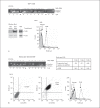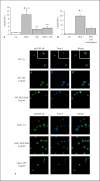Attenuated activation of macrophage TLR9 by DNA from virulent mycobacteria
- PMID: 20375564
- PMCID: PMC7312848
- DOI: 10.1159/000142731
Attenuated activation of macrophage TLR9 by DNA from virulent mycobacteria
Abstract
Alveolar macrophages are the first line of host defence against mycobacteria, but an insufficient host response allows survival of bacteria within macrophages. We aimed to investigate the role of Toll-like receptor 9 (TLR9) activation in macrophage defence against mycobacteria. Human in vitro differentiated macrophages as well as human and mouse alveolar macrophages showed TLR9 mRNA and protein expression. The cells were markedly activated by DNA isolated from attenuated mycobacterial strains (H37Ra and Mycobacterium bovis BCG) as assessed by measuring cytokine expression by real-time PCR, whereas synthetic phosphorothioate-modified oligonucleotides had a much lower potency to activate human macrophages. Intracellular replication of H37Ra was higher in macrophages isolated from TLR9-deficient mice than in macrophages from wild-type mice, whereas H37Rv showed equal survival in cells from wild-type or mutant mice. Increased bacterial survival in mouse macrophages was accompanied by altered cytokine production as determined by Luminex bead assays. In vivo infection experiments also showed differential cytokine production in TLR9-deficient mice compared to wild-type animals. Both human monocyte-derived macrophages as well as human alveolar macrophages showed reduced activation upon treatment with DNA isolated from bacteria from virulent (M. bovis and H37Rv) compared to attenuated mycobacteria. We suggest attenuated TLR9 activation contributes to the insufficient host response against virulent mycobacteria.
Copyright 2008 S. Karger AG, Basel.
Figures







Similar articles
-
Innate cytokine profiling of bovine alveolar macrophages reveals commonalities and divergence in the response to Mycobacterium bovis and Mycobacterium tuberculosis infection.Tuberculosis (Edinb). 2014 Jul;94(4):441-50. doi: 10.1016/j.tube.2014.04.004. Epub 2014 May 5. Tuberculosis (Edinb). 2014. PMID: 24882682
-
Mycobacterium bovis BCG vaccination augments interleukin-8 mRNA expression and protein production in guinea pig alveolar macrophages infected with Mycobacterium tuberculosis.Infect Immun. 2002 Oct;70(10):5471-8. doi: 10.1128/IAI.70.10.5471-5478.2002. Infect Immun. 2002. PMID: 12228272 Free PMC article.
-
Differential cell reaction upon Toll-like receptor 4 and 9 activation in human alveolar and lung interstitial macrophages.Respir Res. 2010 Sep 15;11(1):124. doi: 10.1186/1465-9921-11-124. Respir Res. 2010. PMID: 20843333 Free PMC article.
-
Interaction of antigen presenting cells with mycobacteria.Vet Immunol Immunopathol. 2004 Aug;100(3-4):187-95. doi: 10.1016/j.vetimm.2004.04.007. Vet Immunol Immunopathol. 2004. PMID: 15207456 Review.
-
Macrophage immunoregulatory pathways in tuberculosis.Semin Immunol. 2014 Dec;26(6):471-85. doi: 10.1016/j.smim.2014.09.010. Epub 2014 Oct 30. Semin Immunol. 2014. PMID: 25453226 Free PMC article. Review.
Cited by
-
Sensing of Mycobacterium tuberculosis and consequences to both host and bacillus.Immunol Rev. 2015 Mar;264(1):204-19. doi: 10.1111/imr.12263. Immunol Rev. 2015. PMID: 25703561 Free PMC article. Review.
-
Expression of Toll-like receptor 9 in mouse and human lungs.J Anat. 2013 May;222(5):495-503. doi: 10.1111/joa.12039. Epub 2013 Mar 22. J Anat. 2013. PMID: 23521717 Free PMC article.
-
Unmethylated CpG motif-containing genomic DNA fragment of Bacillus calmette-guerin promotes macrophage functions through TLR9-mediated activation of NF-κB and MAPKs signaling pathways.Innate Immun. 2020 Apr;26(3):183-203. doi: 10.1177/1753425919879997. Epub 2019 Oct 15. Innate Immun. 2020. PMID: 31615313 Free PMC article.
-
Role of pattern recognition receptors in sensing Mycobacterium tuberculosis.Heliyon. 2023 Oct 4;9(10):e20636. doi: 10.1016/j.heliyon.2023.e20636. eCollection 2023 Oct. Heliyon. 2023. PMID: 37842564 Free PMC article. Review.
-
Interactions between CNS and immune cells in tuberculous meningitis.Front Immunol. 2024 Feb 1;15:1326859. doi: 10.3389/fimmu.2024.1326859. eCollection 2024. Front Immunol. 2024. PMID: 38361935 Free PMC article. Review.
References
-
- Doffinger R, Patel SY, Kumararatne DS. Host genetic factors and mycobacterial infections: lessons from single gene disorders affecting innate and adaptive immunity. Microbes Infect. 2006;8:1141–1150. - PubMed
-
- Beutler B. Inferences, questions and possibilities in Toll-like receptor signalling. Nature. 2004;430:257–263. - PubMed
-
- Shimada S, Yano O, Inoue H, Kuramoto E, Fukuda T, Yamamoto H, Kataoka T, Tokunaga T. Antitumor activity of the DNA fraction from Mycobacterium bovis BCG. II. Effects on various syngeneic mouse tumors. J Natl Cancer Inst. 1985;74:681–688. - PubMed
-
- Tokunaga T, Yamamoto H, Shimada S, Abe H, Fukuda T, Fujisawa Y, Furutani Y, Yano O, Kataoka T, Sudo T. Antitumor activity of deoxyribonucleic acid fraction from Mycobacterium bovis BCG. I. Isolation, physicochemical characterization, and antitumor activity. J Natl Cancer Inst. 1984;72:955–962. - PubMed
Publication types
MeSH terms
Substances
Grants and funding
LinkOut - more resources
Full Text Sources
Other Literature Sources
Molecular Biology Databases

